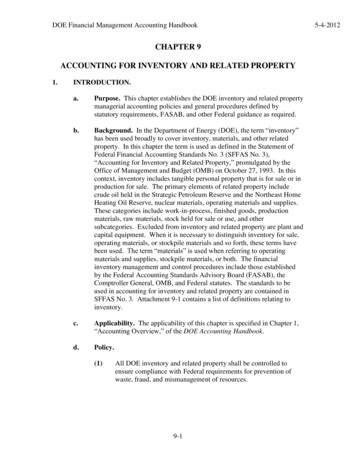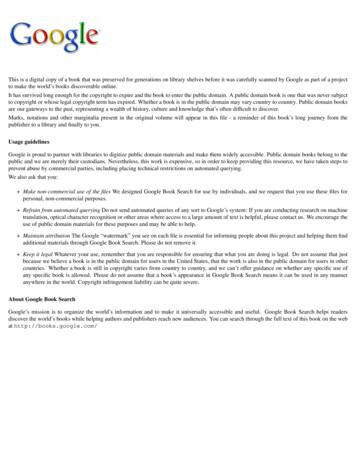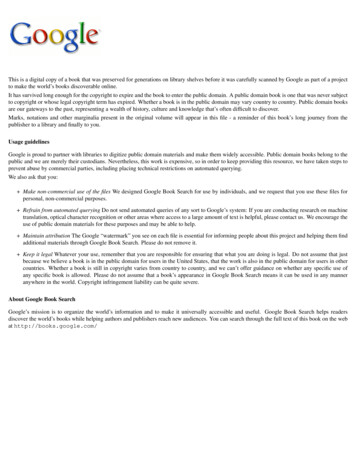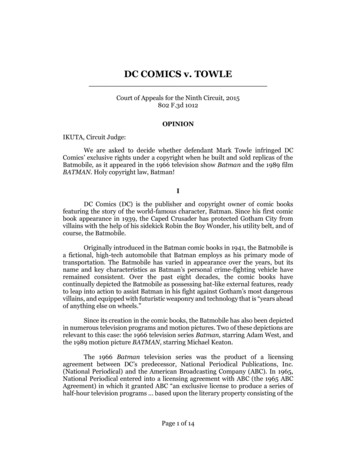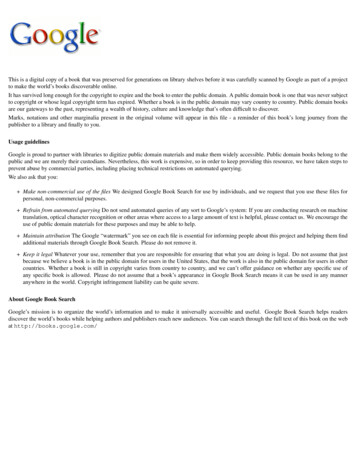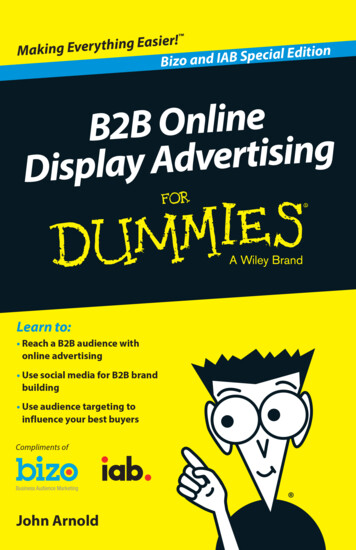
Transcription
These materials are the copyright of John Wiley & Sons, Inc. and anydissemination, distribution, or unauthorized use is strictly prohibited.
B2B OnlineDisplay AdvertisingBizo and IAB Special Editionby John ArnoldThese materials are the copyright of John Wiley & Sons, Inc. and anydissemination, distribution, or unauthorized use is strictly prohibited.
B2B Online Display Advertising For Dummies , Bizo and IAB Special EditionPublished byJohn Wiley & Sons, Inc.111 River St.Hoboken, NJ 07030-5774www.wiley.comCopyright 2014 by John Wiley & Sons, Inc., Hoboken, New JerseyNo part of this publication may be reproduced, stored in a retrieval system or transmitted in anyform or by any means, electronic, mechanical, photocopying, recording, scanning or otherwise,except as permitted under Sections 107 or 108 of the 1976 United States Copyright Act, without theprior written permission of the Publisher. Requests to the Publisher for permission should beaddressed to the Permissions Department, John Wiley & Sons, Inc., 111 River Street, Hoboken, NJ07030, (201) 748-6011, fax (201) 748-6008, or online at http://www.wiley.com/go/permissions.Trademarks: Wiley, the Wiley logo, For Dummies, the Dummies Man logo, A Reference for the Restof Us!, The Dummies Way, Dummies.com, Making Everything Easier, and related trade dress aretrademarks or registered trademarks of John Wiley & Sons, Inc. and/or its affiliates in the UnitedStates and other countries, and may not be used without written permission. All other trademarksare the property of their respective owners. John Wiley & Sons, Inc., is not associated with anyproduct or vendor mentioned in this book.LIMIT OF LIABILITY/DISCLAIMER OF WARRANTY: THE PUBLISHER AND THE AUTHOR MAKENO REPRESENTATIONS OR WARRANTIES WITH RESPECT TO THE ACCURACY ORCOMPLETENESS OF THE CONTENTS OF THIS WORK AND SPECIFICALLY DISCLAIM ALLWARRANTIES, INCLUDING WITHOUT LIMITATION WARRANTIES OF FITNESS FOR APARTICULAR PURPOSE. NO WARRANTY MAY BE CREATED OR EXTENDED BY SALES ORPROMOTIONAL MATERIALS. THE ADVICE AND STRATEGIES CONTAINED HEREIN MAY NOT BESUITABLE FOR EVERY SITUATION. THIS WORK IS SOLD WITH THE UNDERSTANDING THATTHE PUBLISHER IS NOT ENGAGED IN RENDERING LEGAL, ACCOUNTING, OR OTHERPROFESSIONAL SERVICES. IF PROFESSIONAL ASSISTANCE IS REQUIRED, THE SERVICES OF ACOMPETENT PROFESSIONAL PERSON SHOULD BE SOUGHT. NEITHER THE PUBLISHER NORTHE AUTHOR SHALL BE LIABLE FOR DAMAGES ARISING HEREFROM. THE FACT THAT ANORGANIZATION OR WEBSITE IS REFERRED TO IN THIS WORK AS A CITATION AND/OR APOTENTIAL SOURCE OF FURTHER INFORMATION DOES NOT MEAN THAT THE AUTHOR ORTHE PUBLISHER ENDORSES THE INFORMATION THE ORGANIZATION OR WEBSITE MAYPROVIDE OR RECOMMENDATIONS IT MAY MAKE. FURTHER, READERS SHOULD BE AWARETHAT INTERNET WEBSITES LISTED IN THIS WORK MAY HAVE CHANGED OR DISAPPEAREDBETWEEN WHEN THIS WORK WAS WRITTEN AND WHEN IT IS READ.For general information on our other products and services, or how to create a custom For Dummiesbook for your business or organization, please contact our Business Development Department in theU.S. at 877-409-4177, contact info@dummies.biz, or visit www.wiley.com/go/custompub. Forinformation about licensing the For Dummies brand for products or services, contactBrandedRights&Licenses@Wiley.com.ISBN 978-1-118-81255-6 (pbk); ISBN 978-1-118-81359-1 (ebk)Manufactured in the United States of America10 9 8 7 6 5 4 3 2 1These materials are the copyright of John Wiley & Sons, Inc. and anydissemination, distribution, or unauthorized use is strictly prohibited.
Table of ContentsIntroduction. 1How This Book Is Organized. 1Icons Used in This Book. 2Chapter 1: Mapping a B2B Display Ad Strategy . . . . . . . 3Asking the Right Questions Before You Start. 3Navigating Multiple Media Choices. 5Chapter 2: Making an Impression withB2B Ad Creative . . . . . . . . . . . . . . . . . . . . . . . . . . . . . . . . 9Starting with the Goal. 9Considering Multiple Contexts with Your Designs. 11Making Good Creative Decisions a Habit. 11Tackling the Technical Stuff. 13Chapter 3: Targeting, Testing, and Optimizing B2BDisplay Ads Effectively . . . . . . . . . . . . . . . . . . . . . . . . . 15Choosing Ad Placements that Hit Your Target Audience. 15Striving for Data Quality When Targeting. 18Testing and Optimizing Ad Creative. 18Chapter 4: Advertising Your B2B Brand inSocial Media. . . . . . . . . . . . . . . . . . . . . . . . . . . . . . . . . . 21Using Paid Social Advertising on the Major Networks. 21Finding the Perfect Social Advertising Audience. 23Adjusting to Limitations of Ad Creative. 26Bidding for Social Success. 27Chapter 5: Retargeting B2B Display Ads. . . . . . . . . . . . . 29What Is Retargeting?. 29Setting Up a Retargeting Strategy. 29Retargeting Is the New Lead Nurturing. 31Understanding Advanced Retargeting Options. 31These materials are the copyright of John Wiley & Sons, Inc. and anydissemination, distribution, or unauthorized use is strictly prohibited.
ivB2B Online Display Advertising For Dummies, Special EditionChapter 6: Determining B2B DisplayAdvertising Impact. . . . . . . . . . . . . . . . . . . . . . . . . . . . . 33Basic Attribution and Cost Modeling. 33Post-Impression Conversions. 34Reach Metrics. 34Action Metrics. 35Funnel Success Metrics. 35Cross-Program Lift (Or “Measuring the DisplayAlley-Oop”). 37Chapter 7: Ten B2B Advertising Traps to Avoid. . . . . . .39Assuming B2B Advertising Is the Same asConsumer Advertising. 39Underestimating the Value of Branding in the B2B World. 39Targeting Only Companies, not Individuals. 40Assuming All B2B Targeting Is the Same. 40Ignoring Display Advertising’s Ability to Drive Leads. 41Missing the Opportunity to Reach Business PeopleOutside of a Business Environment. 41Overusing Personalization in B2B Marketing. 42Relying Only on Last-Click Attribution. 42Viewing Display Advertising as a Discrete Campaign,not a Strategy. 42Being Afraid to Turn Off Under-performing Campaigns. 43These materials are the copyright of John Wiley & Sons, Inc. and anydissemination, distribution, or unauthorized use is strictly prohibited.
IntroductionB2B decision makers no longer make decisions on theirown. Even C-level buyers operate in an atmosphere ofconsensus and buy-in from multiple coworkers and influencers.Data-driven decision making is the norm, and B2B purchases arebased on facts, input from peers, and a lot of online research.How in the world is your marketing going to make an impactwhen there are so many people on so many websites doing somuch research to decide what to buy from whom?A big part of the answer is B2B online display advertising,which gives you a way to reach your target audience at allstages of a decision-making cycle. You can use your B2Bdisplay ads to increase awareness, generate leads, nurturethem, and help them make a decision. You can reach businesspeople with ads while they are multitasking on social mediasites. You can also measure your results at each stage of themarketing funnel and attribute your advertising to advancingprospects through each step of a decision. You can fine-tuneyour messaging along the way.This book guides you through the process of building andlaunching a B2B online display advertising program, andexplains how you can create, test, target, launch, and measureyour results.How This Book Is OrganizedYou can start with any chapter in this book and use it as areference, or read the whole thing in order cover to cover.Here’s what each chapter covers: Chapter 1: Mapping a B2B Display Ad Strategy explainsthe steps involved in planning your online advertisingand getting ready to launch. Chapter 2: Making an Impression with B2B Ad Creativeshows you how to design impactful, online display advertising creative.These materials are the copyright of John Wiley & Sons, Inc. and anydissemination, distribution, or unauthorized use is strictly prohibited.
2B2B Online Display Advertising For Dummies, Special Edition Chapter 3: Targeting, Testing, and Optimizing B2BDisplay Ads Effectively walks you through the methodsof targeting an audience and optimizing ads throughtesting. Chapter 4: Advertising Your B2B Brand in Social Mediaexplains how to nurture leads by placing online displayadvertising on Twitter, LinkedIn, and Facebook. Chapter 5: Retargeting B2B Display Ads introduces youto the power of basic and advanced retargeting. Chapter 6: Determining B2B Display Advertising Impactshows you how to measure your online display advertisingand attribute impact to each ad. Chapter 7: Ten B2B Advertising Traps to Avoid is alist of the most common B2B online display advertisingmistakes.Icons Used in This BookIcons are used throughout this book to call attention tomaterial worth noting in a special way. Here’s what eachmeans:Some points bear repeating, and others bear remembering.When you see this icon, take special note of what you’reabout to read.This icon indicates technical information that is probablymost interesting to techies, but you never know when youmay need to talk to one.This icon indicates a suggestion that will help you do something faster or avoid repeating someone else’s mistake.These materials are the copyright of John Wiley & Sons, Inc. and anydissemination, distribution, or unauthorized use is strictly prohibited.
Chapter 1Mapping a B2B DisplayAd StrategyIn This Chapter Answering strategic questions Planning for the greatest impact Focusing on B2B audiencesWhen it comes to B2B display advertising, your company will be profitable much sooner if you take thetime to think through the most important details about yourstrategy in advance of your first campaign launching.In this chapter, I show you which types of display ad strategies to consider from among the many choices availableto B2B marketers. I also explain how to get your ads in frontof B2B audiences and which questions to ask before youbegin advertising.Asking the Right QuestionsBefore You StartDisplay advertising gives you a lot of metrics you can use tomake decisions and optimize campaign performance, but it’sa good idea to answer the following questions before youThese materials are the copyright of John Wiley & Sons, Inc. and anydissemination, distribution, or unauthorized use is strictly prohibited.
4B2B Online Display Advertising For Dummies, Special Editionbegin. Answering these questions also allows you to prioritizethe steps involved in launching your first or next displayadvertising campaign. Where does your company need to make an impact?To answer this question, think about your company’sexperience with your target prospect audiences andthe typical decision-making cycle they go through frombeginning to end. Then, determine where advertising isneeded to attract new buyers, educate them, and influence final purchase decisions. Who is your target audience and how will your displayads reach them? To answer this question, describe yourmost profitable prospects in as much detail as possibleon an industry level, company level, and role level. Youneed this information to target the audiences that mattermost to your business. How will you define success? You need to choose yourmetrics wisely depending on whether the end-goal ofyour campaign is to increase awareness of your companyand products, more deeply educate target prospects,or tee them up for a sales conversation. For example,if you’re looking for your display campaign to increaserecognition of your brand, measuring its success basedon clicks or leads generated is most likely a dead end. Idiscuss metrics and multi-channel attribution modelingin more detail in Chapter 6. Which goals will drive your ad creative? Your ad creativedrives the actions your audience takes when engaging withyour ad impressions, so it’s important to define your goalsand build your creative to suggest the actions that moveyour target audience toward your goals. For example, ifone of your goals is brand awareness, your creative islikely to emphasize logos, colors, and emotions. I explaineffective ad creative in detail in Chapter 2. Where will you focus your time and money? This is aquestion you should not only answer at the beginning ofa new strategy, but also frequently throughout the implementation of your strategy as you target, test, track, andoptimize your ads for better results. I explain testing,targeting, and optimizing in Chapter 3.These materials are the copyright of John Wiley & Sons, Inc. and anydissemination, distribution, or unauthorized use is strictly prohibited.
Chapter 1: Mapping a B2B Display Ad Strategy5Navigating MultipleMedia ChoicesAccording to a 2012 study by Forrester Research, Americansare spending almost 20 hours per week on the Internet onthe average. That’s good news if you want to reach youraudience with online display advertising. The challenge isreaching the right audience frequently enough when there aremore than 600 million websites for Americans to choose fromwhen spending their time browsing.The next sections show you how to build an online displayad strategy that will reach your target business audience andgive you the best chance of success without wasting time andmoney on ineffective ad placements.In order to ensure your B2B ads aren’t ignored, your strategyneeds to include the following three components: Sophistication: Your ads need to be served by a smarttechnology platform that allows you to automaticallyserve ads to the right audience in the right place at theright time. Versatility: You need to choose advertising that hasthe ability to impact all stages of your audience’sdecision-making cycle. Fortunately, this is a somewhatbuilt-in capability of display advertising as shown inFigure 1-1. Timing: Your ads need to be in front of your audienceearly, often, and throughout the buying cycle, to ensureyour brand is one of those included on the evaluationshortlist.These materials are the copyright of John Wiley & Sons, Inc. and anydissemination, distribution, or unauthorized use is strictly prohibited.
6B2B Online Display Advertising For Dummies, Special EditionFigure 1-1: Display advertising can influence all stages of a decision-makingcycle.Planning for audience impressions,not ad impressionsA good strategy doesn’t only aim at placing display ads onspecific websites. Instead, your strategy should focus on placing your advertising creative in front of business influencersand decision makers. To do that, you need to plan for audience impressions, not ad impressions.Ad impressions refer to the appearance of your ad creativeon a website. Although there are many ways publishers whoprovide advertising space can count ad impressions, an adimpression is only valuable to your business if the impressionis seen by someone. It’s impossible to know whether your adimpression was actually seen by someone, but you don’t haveto be satisfied with counting anonymous impressions if youinstead focus your strategy on audience impressions.Audience impressions happen when someone who meets thecharacteristics of your target audience visits a website containing one of your ad impressions. Audience impressionsThese materials are the copyright of John Wiley & Sons, Inc. and anydissemination, distribution, or unauthorized use is strictly prohibited.
Chapter 1: Mapping a B2B Display Ad Strategy7are made possible when publishers share anonymous dataabout a web visitor with your audience-targeting platform.The result is advertising space that is more likely to reachyour target audience than space based on content or a type ofwebsite alone. I explain audience-targeting platforms in moredetail a little later in this chapter.Focusing on a suitable rangeof marketing goalsThinking through all of your marketing goals and prioritizing them can help you focus your strategy on making goodadvertising decisions. By taking these steps, you can achieveyour most important marketing goals throughout the buyingprocess.For the broadest perspective, take the following steps foreach display advertising campaign you’re planning to launch.1. Determine where your target audience is in the marketing funnel.Your audience advances through the funnel, so youshould include each funnel stage in your campaignstrategy. Remember that B2B sales cycles can take alot longer than most consumer sales cycles. So, it’simportant to define your funnel stages.2. Define your goals and the display strategy mostlikely to achieve your goals in each stage.3. Determine which actions you want your prospects totake after viewing your ads and choose the metricsthat are best suited to measuring the success of thoseactions.For example, you may want your target audience torecognize your brand over your competitors, registerfor a webinar, or purchase a product. So, you couldchoose to focus your ads on share of voice, pagevisits, and conversion lift, respectively, as prospectsmove through the funnel.These materials are the copyright of John Wiley & Sons, Inc. and anydissemination, distribution, or unauthorized use is strictly prohibited.
8B2B Online Display Advertising For Dummies, Special EditionBuying direct from publishersMany large publishers of online content offer advertisingspace directly. Going direct allows you to target the typicalvisitors that publisher receives; however, the audience is limited by the number of visitors that publisher receives on itsown web properties who may or may not be in an advertiser’starget audience. Additionally, you may miss out on exposingyour brand to target audiences who may be visiting all of theother sites on the web.Buying through ad networksAdvertising networks are companies that buy advertising spacefrom multiple publishers and allow you to reach a larger audience than you otherwise would by advertising directly with asingle publisher.Buying through audiencetargeting platformsAudience-targeting platforms are similar to advertising networks, because they allow you to reach multiple audienceson multiple websites from one platform. But, unlike most adnetworks, audience-targeting platforms enable you to displayyour advertising based on B2B audience data such as jobfunction, industry, company size, seniority, and more.Audience targeting can be extremely precise, allowing you toreach (and spend money) only on the people who matter toyour business. For example, a website with B2B content mightattract job seekers who are not good prospects for your company’s products or services. Audience targeting can help keepyour ads from displaying to these less valuable visitors.These materials are the copyright of John Wiley & Sons, Inc. and anydissemination, distribution, or unauthorized use is strictly prohibited.
Chapter 2Making an Impressionwith B2B Ad CreativeIn This Chapter Considering offers and landing pages Designing display ads that stand out Making technical creative considerationsWhen your advertising appears in a web page, the levelof engagement the ad deserves from your target audience depends almost entirely on the ability of your ad creative to entice your audience. This chapter shows you how todevelop interesting, attention-grabbing, actionable advertisingcreative and associated landing pages and offers.Starting with the GoalDesigning good ad creative should begin with defining whereyou want to make an impact on the marketing funnel. (I showyou how to define marketing goals in Chapter 1.)After you know exactly who you’re targeting and why, you needto start with the end in mind by defining which actions youwant your audience to take when they click through on yourad and end up on the landing page associated with your ad. Alanding page is a web page that is built or chosen specificallyto accept all the visitors who click on one or more ads and tellthem what you want them to do next. Examples include fillingout a form in exchange for expert research or advice or scheduling a demo.These materials are the copyright of John Wiley & Sons, Inc. and anydissemination, distribution, or unauthorized use is strictly prohibited.
10B2B Online Display Advertising For Dummies, Special EditionYour landing page and offer should be in sync with your advertising targeting or creative. The more effective your landingpage and your offer, the fewer clicks it takes to move peopleahead in a buying decision and the lower your overall cost ofconversion.The landing pageYour landing page creative should match your ad creativevisually. But, there’s more to it than that. You need to treatyour advertisement as a teaser that attracts a click, and yourlanding page as an offer that invites a commitment. In orderfor your landing page creative to drive a commitment, createa landing page for each version of your ad, and make sure it’sconcise and as easy as possible for people to read the pageand fill out any information you ask for.The offerIt’s essential to test a variety of offers so you can optimize theactions taken through your ads.Before investing in a large-scale advertising campaign, use A/Boffer testing with two offers across a smaller pool of targetedad impressions to determine which creative choices are moresuccessful. A/B offer testing is the process of creating two ads,each with one altered variable in the offer, and testing theresults of each ad. For example In ad version A, the offer copy is Free Whitepaper. In ad version B, the offer copy is Free Trial.A/B testing isn’t a one-time decision. You should continuouslytest A and B versions of your offers to keep the best performing ads deployed and to replace ads with other offers youthink of as your campaigns continue to run.These materials are the copyright of John Wiley & Sons, Inc. and anydissemination, distribution, or unauthorized use is strictly prohibited.
Chapter 2: Making an Impression with B2B Ad Creative11Considering Multiple Contextswith Your DesignsDesigning for marketing funnel context means your advertisingcreative should be altered based on where you’re looking tomake an impact on the marketing funnel. For example: Top-funnel creative should be focused on brand awareness to drive more people into the top of your marketingfunnel. You don’t need to drive people to download awhitepaper or sign up for a webinar. Your goal shouldbe for business decision-makers to understand whoyou are and what you do. If you generate any leads atthe branding stage, consider it a bonus. The top-funnelmetrics that really matter are brand recall, awareness,and increasing the number of visits to your website fromyour target audience. Mid-funnel creative should be designed to educate andengage your target prospects. At this point in the marketing funnel, your creative should push content to userswho were already familiar with your brand (thanks toyour top-funnel branding campaign). This is a good timeto offer prospects a valuable whitepaper or report thateducates them about the value of your solutions. Bottom-funnel creative should be designed to drive conversions. Your creative needs to convey the value of youroffer clearly and succinctly. Once you have your bottomfunnel creative developed, align it with your retargetingstrategy. I explain retargeting in Chapter 5.Making Good CreativeDecisions a HabitDesigning display ads is both an art and a science. The art isapplying visually appealing, attractive, and often surprisingelements in your ads. The science is knowing your audienceand validating your decisions with data and testing. The nextsections show you how to home in on the art and sciencecombinations that will get you the best results.These materials are the copyright of John Wiley & Sons, Inc. and anydissemination, distribution, or unauthorized use is strictly prohibited.
12B2B Online Display Advertising For Dummies, Special EditionChoosing images and ad copyYour creative decisions should strike a balance betweenfocusing on the information you want to get across and usinga tone, words, and images that will grab the attention of theaudience you’re targeting. Here are some tips for making yourimages and copy effective. Your ads should contain a single highly focused message.Remember, your ad should be designed to attract interest, not confuse your audience with options. Your ads should include a good measure of “emptyspace” with no images or copy. The space around yourad makes your copy stand out. Your logo should be placed in a prominent position. Ifyou want to occupy the mind share of your prospects,your logo should be highly visible. Don’t merely convert print or other offline creative to adisplay format. Design specifically for display. Your call to action should be clear, as shown in Figure 2-1.Explain exactly what is going to happen when the ad isclicked. Don’t say “click here.” Instead, use more descriptive words such as visit, download, watch, or read.Figure 2-1: Use a clear and concise call to action.Designing to differentiateIf you aim to win sales from the people in your target audience, you had better aim to win attention away from yourcompetition. Use your creative to differentiate your businessfrom the competition by making sure your creative is uniqueThese materials are the copyright of John Wiley & Sons, Inc. and anydissemination, distribution, or unauthorized use is strictly prohibited.
Chapter 2: Making an Impression with B2B Ad Creative13and demonstrates your superior expertise, pricing, service,sales process, or whatever sets you apart.Creating flexible design elementsfor targeted messagesOne significant benefit of using display advertising is the ability to clearly target specific audience groups, according to jobfunction, company size, and other demographic data.Use this flexibility to your advantage by developing differentad creative for targeting purposes. For example, you can createdifferent ads for targeting buyer personas, such as C-level executives, mid-management, and individual contributors. Use yourvariations to test and fine-tune messages and offers related tothe products or value propositions that matter most to eachpersona.Tackling the Technical StuffOnline display ads are actually graphics files of various sizesand formats. The collective design elements in a display adare known as the ad creative.The following sections give you the information you need tomake decisions about the ad creative you use to build yourB2B brand.Display ad unit sizesand placementsAd units are fixed areas of space on a web page where adsappear when the space is purchased. Here are the mostcommon ad standards according to the IAB StandardPortfolio: 300x250 pixels for a medium rectangle ad 180x150 pixels for a rectangle ad 160x600 pixels for a wide skyscraper adThese materials are the copyright of John Wiley & Sons, Inc. and anydissemination, distribution, or unauthorized use is strictly prohibited.
14B2B Online Display Advertising For Dummies, Special Edition 728x90 pixels for a leaderboard ad 970x250 pixels for a billboard ad 300x600 pixels for a filmstrip ad 300x1050 pixels for a portrait ad 970x90 pixels for a pushdown ad 300x250, 300x600, or 970x250 pixels for a sidekick ad 970x90 pixels for a slider adThere are many other new, rich ad formats designed forgreater interaction and impact that B2B marketers can learnmore about at www.iab.net.Your ad creative has to include a slightly different design toaccommodate each ad unit. For example, you may need toreword a headline or offer to fit in a smaller ad space whilestill maximizing the size of the text. A typical ad-serving platform enables you to upload all of the possible ad units sothat the platform can detect the appropriate ad unit sizes fora given placement and automatically choose the ad size thatmatches the ad unit and positioning on the page.Creative options in variousfile formatsIn addition to sizing your display ads correctly, your ads needto have the correct file format. Depending on the publisher,your ad creative could be displayed as a static image or in afile format that allows animation of the ad creative. Use thestandard file formats for most advertising networks. For staticimages, use .gif, .jpeg, or .swf. For animated ads, use .asf, mpeg,or .avi.For the best results, create your ads in all of the formats andthen upload them to your ad-serving platform, so the platformcan automatically select the proper format required by thepublisher.These materials are the copyright of John Wiley & Sons, Inc. and anydissemination, distribution, or unauthorized use is
2 B2B Online Display Advertising For Dummies, Special Edition Chapter 3: Targeting, Testing, and Optimizing B2B Display Ads Effectively walks you through the methods of targeting an audience and optimizing ads through testing. Chapter 4: Advertising Your B2B Brand in Social Media explains how to




